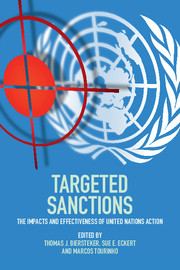Book contents
- Frontmatter
- Contents
- List of figures
- List of tables
- List of contributors
- List of abbreviations
- Introduction
- 1 Thinking about United Nations targeted sanctions
- 2 The purposes of targeted sanctions
- 3 Security Council dynamics and sanctions design
- 4 United Nations targeted sanctions and other policy tools: diplomacy, legal, use of force
- 5 The relationship between United Nations sanctions and regional sanctions regimes
- 6 Coordination of United Nations sanctions with other actors and instruments
- 7 Implementation of United Nations targeted sanctions
- 8 The impacts of United Nations targeted sanctions
- 9 The unintended consequences of United Nations targeted sanctions
- 10 The effectiveness of United Nations targeted sanctions
- 11 Institutional learning in targeting sanctions
- 12 Conclusion
- Appendix 1 List of cases and episodes
- Appendix 2 Sanctions effectiveness
- Appendix 3 TSC database codebook
- Appendix 4 Targeted Sanctions Consortium (TSC) participants
- Bibliography
- Index
7 - Implementation of United Nations targeted sanctions
Published online by Cambridge University Press: 05 March 2016
- Frontmatter
- Contents
- List of figures
- List of tables
- List of contributors
- List of abbreviations
- Introduction
- 1 Thinking about United Nations targeted sanctions
- 2 The purposes of targeted sanctions
- 3 Security Council dynamics and sanctions design
- 4 United Nations targeted sanctions and other policy tools: diplomacy, legal, use of force
- 5 The relationship between United Nations sanctions and regional sanctions regimes
- 6 Coordination of United Nations sanctions with other actors and instruments
- 7 Implementation of United Nations targeted sanctions
- 8 The impacts of United Nations targeted sanctions
- 9 The unintended consequences of United Nations targeted sanctions
- 10 The effectiveness of United Nations targeted sanctions
- 11 Institutional learning in targeting sanctions
- 12 Conclusion
- Appendix 1 List of cases and episodes
- Appendix 2 Sanctions effectiveness
- Appendix 3 TSC database codebook
- Appendix 4 Targeted Sanctions Consortium (TSC) participants
- Bibliography
- Index
Summary
The United Nations Charter does not mention the word ‘sanctions’ nor does it provide any guidance as to how decisions made by the Security Council regarding ‘measures not including the use of force’ under Article 41 should be implemented. Article 25 states, ‘The Members of the United Nations agree to accept and carry out the decisions of the Security Council in accordance with the present Charter.’ This has been widely interpreted to mean that Member States are the primary implementers of sanctions. While true, states are not solely responsible for carrying out UN sanctions. In fact, a broad range of UN and other international actors – the Secretariat, sanctions committees, Panels of Experts, regional and international organizations, civil society, and the private sector – share this obligation and play essential roles in implementing UN sanctions.
Misperceptions based on misplaced emphasis on Member States’ implementation duties have allowed the UN Secretariat and UN agencies to eschew implementation responsibilities. Failure to recognize and apportion implementation responsibilities to multiple actors, including the Secretariat and UN agencies, has hampered the effectiveness of UN sanctions. In addition, there is insufficient recognition of what should be self-evident: certain types of sanctions, such as assets freezes and others, cannot effectively be implemented without intense collaboration between the sanctions committees, expert panels, the Secretariat, UN agencies, regulatory institutions of member states, international organizations, and most importantly, banks and other private sector actors.
Targeted sanctions are more complex to implement than comprehensive sanctions and therefore require greater technical skills and expertise. This poses significant capacity challenges for many Member States and other actors within the UN system. Because of the interrelationship between capacity and political will, it is often difficult to determine whether deficiencies in implementation or noncompliance are attributable to the lack of capacity or to an absence of political will. While technical assistance for counterterrorism and non-proliferation sanctions – purposes that enjoy the greatest political unity among the Permanent Five members of the Security Council – has been available, this has not been the case for most other sanctions regimes.
Moreover, implementation is often complicated by the range of tools utilized by the international community in parallel with sanctions. Peacekeeping missions, mediation and other diplomatic efforts, humanitarian assistance, special envoys, and work of specialized agencies are among the many other policy instruments employed in addressing international crises.
- Type
- Chapter
- Information
- Targeted SanctionsThe Impacts and Effectiveness of United Nations Action, pp. 150 - 171Publisher: Cambridge University PressPrint publication year: 2016
- 1
- Cited by



